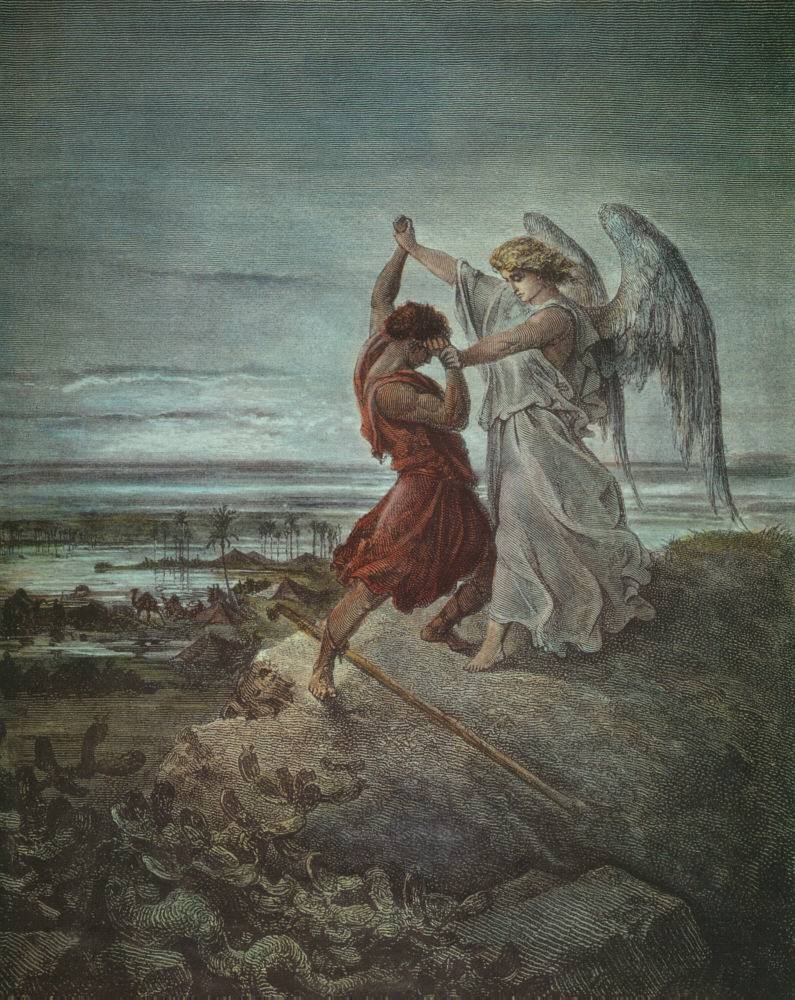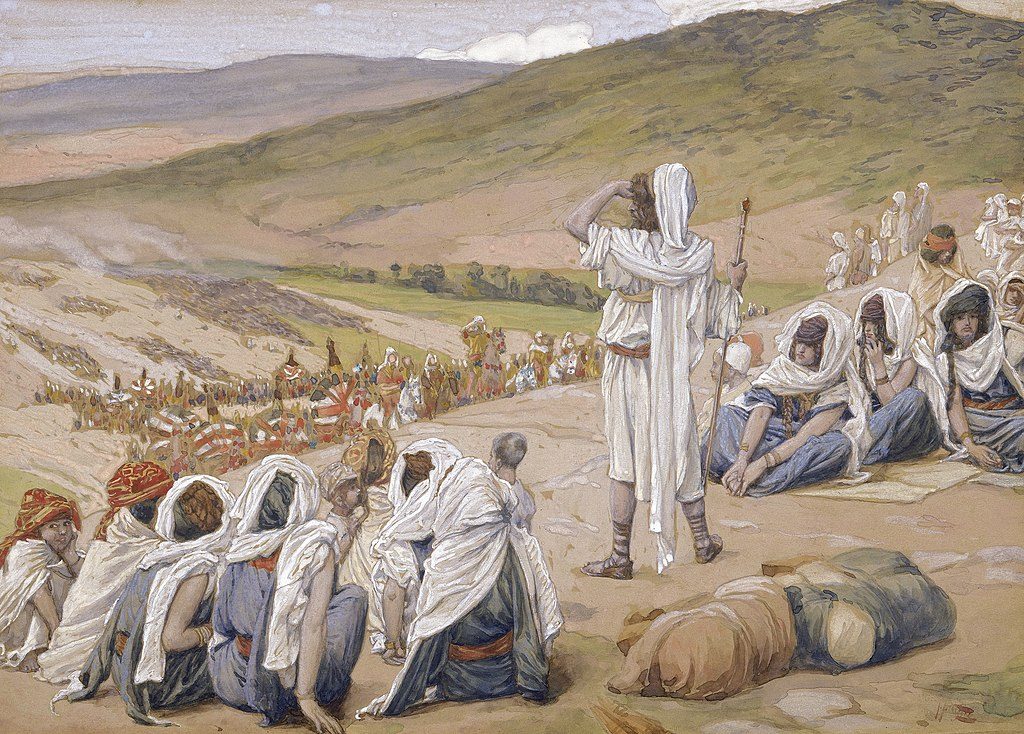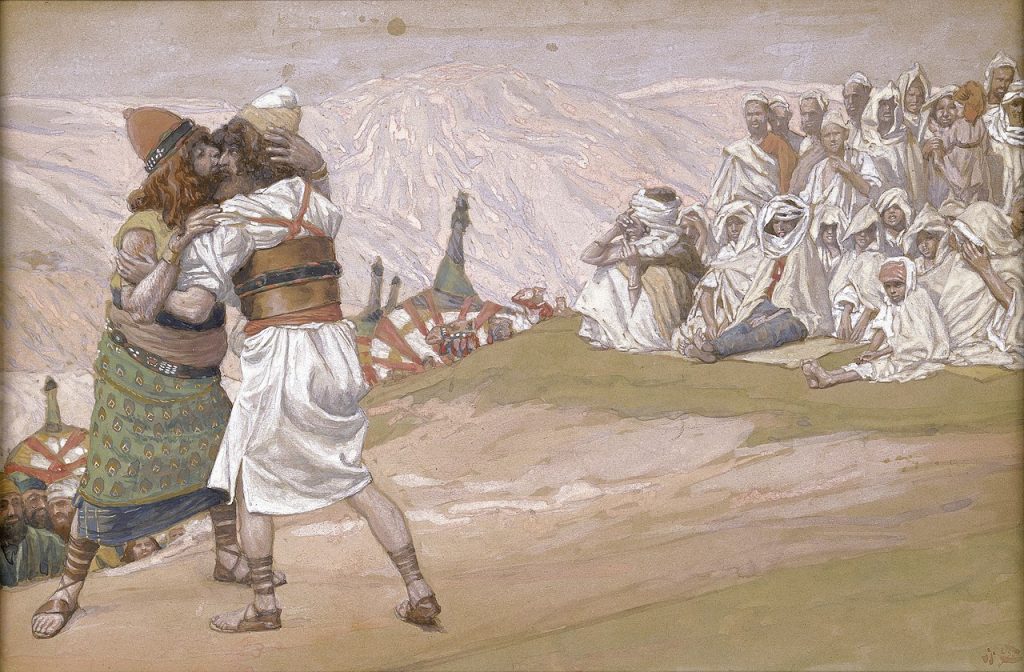And he sent
Yaakov’s life was one of never-ending struggles. Yaakov is leaving Lavan’s territory. After more than 20 years of separation, Yaakov is about to meet Esav, who had vowed to kill him, and try to reconcile their differences. In order to prepare for the encounter, Yaakov sent angelic messengers to find out Esav’s whereabouts, The messengers returned, informing Yaakov that Esav was approaching with an army of 400 people, and potentially looking for revenge for the blessings which Yaakov had rightfully taken (Bereishit Rabbah 75:12).
Yaakov’s preparations
Yaakov immediately prepared for war, dividing his camp in two so that if one fall the other would survive; he prayed to G-d, and also he prepared a lavish gift for Esav, to bribe him and perhaps avoid the fight. As the presents went before him, Yaakov took his wives, handmaids, children, and belongings over the Yabok river, and then remained behind that night alone.
Yaakov Wrestling with the Angel

Yaakov wrestled with a “man” until dawn, and when the “man” saw that he was not prevailing, he touched the hollow of Yaakov’s thigh and strained it. The man asked Yaakov to let him go, for the day was breaking, but Yaakov would not let him go without a blessing. The man asked Yaakov his name, and when he replied “Yaakov” the man told him that his name would no more be Yaakov, but Israel, for he had striven with G-d and with men and prevailed.
“Esav hates Yaakov”
This week’s parsha, Va’yishlach, has generated one of the most often quoted statements in Rabbinic literature. The statement is made by Rabbi Shimon bar Yochai : “It is a halacha (Jewish law) that we know that Esav hates Yaakov.” (for buying the status of first born from him for a bowl of lentils, and subsequently stealing their father’s blessing.)

All in the family
It is hard, from a parental point of view to accept the reality, that sometimes, sibling issues may escalate to an extreme hate within the family. This fraternal discord is believed to continue between the descendants of Yaakov and the descendants of Esav. The statement is liberally thrown around when discussing the Holocaust, anti-Semitism, anti-Israel activity, and the general violent animosity the non-Jewish world in general has for the Jews. It is used, in this version, as a halacha, a law, a rule, something that has been determined and is now unassailable. It is often used to justify and even encourage enmity and violent action against non-Jews because, after all, the halacha says they hate us.
Yaakov and Esav meet

When they finally do meet, the Torah tells us that, seeing Yaakov, his family, and possessions, Esav runs to greet him, embraces him, falls on his neck, kisses him, and the two brothers weep. The word וישקהו, and he kissed him, is written in the Torah with a dot over each letter. These dots, which appear a few times over words and letters in the Torah, are usually understood by the Rabbis to hint at some dual meaning: the text does not mean exactly what it says. It is only partially true, or true in some circumstances but not others, or refers to something other than what it appears to refer to.

Real versus fake
There is a Rabbinic argument about what the dots over “and he kissed him” mean. One position is that they indicate that the kiss was not real, it was done without any real feeling. Others say it was not a kiss at all, and that Esav actually tried to bite Yaakov on the neck, and that Yaakov was saved by a miracle which turned his neck into marble, breaking Esav’s teeth. The other school of thought sees the verse as meaning just what it says: Esav and Yaakov were both moved to tears by their reunion, and the kiss was just a kiss, real and heart-felt.

Can people change?
Esav’s hatred is human, understandable, and, therefore, might have been shifted, affected by events. Rabbi Shimon bar Yochai says, in the moment he is reunited with Yaakov, he really feels love for him; he is moved by Yaakov’s presence, behavior, and words. His feelings for him change, as feelings do.
Looking forward
In the Halachic Midrash on Numbers, the Sifrei, Rabbi Shimon Bar Yochai explains the dots this way: “It is known that Esav hates Yaakov, but his mercy was engaged at that moment and he kissed him with all his heart.” According to Rav Shimon bar Yochai, the dots do something unusual: they tell us that even though our knowledge of Yaakov and Esav’s history would lead us to understand this kiss was not real, we shouldn’t let our knowledge of their personal history push us into a creative reading. Rather, we should just accept that Esav really was moved by this reunion to feel and show love to his brother. The dots tell us the opposite of what they usually do: in spite of everything that went before, Esav felt real love for Yaakov.
Esav’s grandson-Amalek
Hate brings hate. Planting seeds of hate creates destruction. Was it a coincidence that Amalek was Esav’s grandson? Amalek is the nation described in the Hebrew Bible as the enemies of the Israelites. The name “Amalek” can also refer to Esav’s descendants, the Amalekites; or the territories of Amalek which they inhabited.
Do you believe people can change? true, people are not always consistent, not always coherent, however, can circumstances and situations change us? can nurture overcome nature? It is hard to answer. Some may say yes, and some may say no. If we believe people can change, as individuals and as a nation, it would be safe to accept the possibility that even people who may have reasons to hate us, can hopefully, come to love us.
Sibling rivalry
The psychologist Dorothy Rowe wrote the book “My Dearest Enemy, My Dangerous Friend” about sibling rivalry, notes: “All sibling relationships are based on the sense of protecting the self. Sibling relationships are … about being validated or invalidated as a person.
“A small child engaged in trying to reconcile his need to be good with his need to be the person he is discovering himself to be, also discovers shame, feeling that he is exposed and vulnerable to annihilation, and even wanting annihilation in order to escape from the mocking, hostile eyes that are upon him. For small children often discover shame at the hands of their older siblings who laugh at them and scorn them … for being unable to do the things they can do.” In other words, older siblings are in a very powerful position with respect to the younger and the temptation is, at times, to try and psychologically destroy them. For not only can they be irritating, but they are rivals who “steal” attention and love. The result on the side of the younger can be an enduring sense of shame.
There is a thin line between love and hate. May we always plant seeds of love, as it is the only way to bring peace into our world.
Shavua Tov.
In The Torah there are 613 commandments, mitzvot, also known as the Law of Moses (תרי״ג מצוות, taryag mitzvot). The 613 mitzvot are first recorded in the 3rd century CE, when Rabbi Simlai mentioned it in a sermon that is recorded in Talmud Makkot 23b.
The 613 commandments include 248 “positive commandments”, to perform an act (mitzvot aseh), and 365 “negative commandments”, to abstain from certain acts (mitzvot lo taaseh). The negative commandments number 365, which coincides with the number of days in the solar year, and the positive commandments number 248, a number ascribed to the number of bones and main organs in the human body.
Though the number 613 is mentioned in the Talmud, its real significance increased in later medieval rabbinic literature, including many works listing or arranged by the mitzvot. The most famous of these was an enumeration of the 613 commandments by Maimonides, The Rambam.
Many of the mitzvot cannot be observed now, following the destruction of the Second Temple, although they still retain religious significance. According to one standard reckoning, there are 77 positive and 194 negative commandments that can be observed today, of which there are 26 commands that apply only within the Land of Israel. Furthermore, there are some time-related commandments from which women are exempt (examples include shofar, sukkah, lulav, tzitzit and tefillin). Some depend on the special status of a person in Judaism (such as kohanim), while others apply only to men or only to women.
According to Rambam Organized by Parsha. based on Wikipedia and http://www.vaadrv.org/rambam613mitzvot.asp ONE BIG IMPORTANT NOTE WHEN USING THIS LISTING: This listing is not all inclusive. Rambam may site multiple sources for a mitzvah is his works but this list currently only gives one source for each mitzvah.
One mitzvah in Parashat Vayigash
- Not to eat the sinew of the thigh Gen 32:33
Check out YedidYah “Let There Be Light” a song about The Story of Creation. Music and Lyrics by Rabbi Yakira Yedidia https://www.youtube.com/watch?v=H0GEYQYwDI0
#####
This blog article was inspired by chabbad.org

